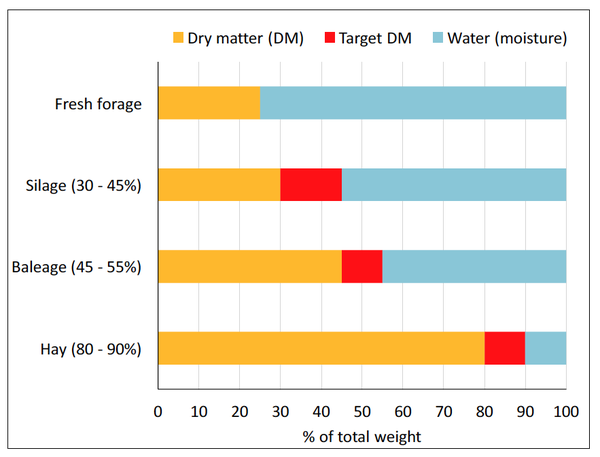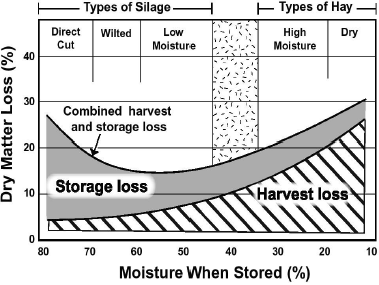Forages can be conserved in the form of hay, baleage, and silage. It is important to keep in mind that, at best, conserved forages can rarely match the nutritive value of fresh forage. Some losses of highly digestible nutrients start immediately after cutting and are unavoidable. The goal in forage conservation is to focus on minimizing losses.
Should I Make Hay, Baleage, or Silage?
Take into account the suitability of the forage for either method, storage capability, weather conditions, and the intended use of the conserved forage (e.g. on-site vs. off-site consumption). Corn is usually considered an ideal crop for ensiling because of higher water-soluble carbohydrate (WSC) concentration compared to other forages and because dry matter (DM) concentration is usually ideal (30% to 35% DM concentration) when harvested at milk stage. In general, crop suitability for ensiling follows the order of: corn, sorghum > ryegrass, orchardgrass, fescue, smallgrains > switchgrass, bermudagrass > legumes. In terms of hay production, as plant stem thickness increases, the less suitable the crop is for hay production. Thicker stems translate in greater radial distance from the stem core to the epidermis, which is the distance that water must travel to move out of the plant. Therefore, achieving high DM concentration (80 to 90% DM concentration) and consequently low moisture (< 20% moisture) conditions within 3-4 days could be challenging with thicker-stemmed forages compared to plants with thinner stems (e.g. bermudagrass, tall fescue) which are better suited for hay production.
What is the Difference Between Hay and Silage?
Hay is forage conserved in aerobic and limited moisture conditions (target should be < 20% moisture, or greater than 80% DM concentration). Silage is forage conserved under anaerobic conditions (oxygen free) and enough moisture (50-70% moisture suggested) to promote fermentation and acidity generation (low pH). Each strategy allows to successfully block growth of spoilage microbes (Figure 1).
Production of Hay
What weather conditions are conducive to good hay-making?
High temperature, high solar radiation, and moderate wind speed (up to 12 mph). Also, look for low relative humidity (no more than 70%) and dry soils.
At what plant maturity stage and how frequently should I mow?
The goal should be to mow at appropriate stubble height and frequency to ensure plant persistence and achieve high yields of high nutritive value forage. As a general rule, legumes should be clipped at early bloom and grasses (specially annuals) at boot to early head stages (Table 1). Clipping heights should ~2-4 in for alfalfa and smallgrains, 3-4 in for tall fescue, orchardgrass, and ~2-3 in for bermudagrass. Estimates of nutritive value at a given physiological stage can be found in Ext. Pub. AG-803.
Table 1. Recommended crop stages to harvest various forage crops
| Forage | Time of Harvest |
|---|---|
| Alfalfa | Late bud to first flower for first cutting, first flower to 1/10 bloom for second and later cuttings. |
|
Bluegrass, Orchardgrass, Tall Fescue, or Timothy |
Boot1 to early head stage for first cut, aftermath cuts at 4- to 6-week intervals. |
| Red Clover or Crimson Clover | First flower to 1/10 bloom. |
| Oats, Barley, or Wheat | Boot to early head stage. |
| Rye and Triticale | Boot stage or before. |
| Annual Lespedeza | Early bloom and before bottom leaves begin to fall. |
|
Ladino Clover or White Clover, Sudangrass, Sorghum Hybrids, Pearl Millet, and Johnsongrass |
Cut at correct stage for companion plant. 30 to 40-inch height or early boot stage, whichever comes first. |
| Bermudagrass Caucasian Bluestem |
Cut when height is 15 to 18 inches. Boot to early head stage. |
| Big Bluestem, Indiangrass, and Switchgrass | Early head stage. |
1Boot is stage of growth of a grass just prior to seedhead emergence. This stage can be identified by the presence of an enlarged or swollen area near the top of the main stem.
What can I do to speed up drying?
Conditioning (crimps and crashes stems an increases surface area exposed to air) can speed up drying rate and lower drying time by 1-2 days by physically breaking the stems. For alfalfa, check for crimped/broken stems every 4”, 90% stems should be crimped/broken, < 5% leaves bruised or broken. Tedding can speed up drying rates by ½ day, but only do when forage has > 40% moisture to prevent leaf losses (shattering).
At what moisture should I bale for hay?
Bale when forage moisture concentration is lower than 20% (or DM concentration is higher than 80%). For every unit increase of moisture over 10% moisture there is a 1%-unit loss in dry matter during storage.
What will happen if I bale my hay too wet?
Spoilage starts, plant respiration and microbial activity consume sugars and proteins, leaving behind fiber. As a consequence of microbial activity, heat will be generated (trigger Maillard reactions that result in less digestible compounds) and temperature can easily surpass 110ºF after a few days, lasting for many days. Risk of fire (instant combustion) is also significant under these conditions. In addition, molds can proliferate producing mycotoxins that can impact animal health and create a potential health hazard for humans consuming animal products. Heat generated can reduce the availability of remaining digestible protein and sugars for livestock.
What can I do if I cannot avoid baling the hay wet?
One option is to use wrap the baled forage and produce baleage (when moisture is 45 – 55%), if you have the equipment available for baleage production. Another option could be to apply acetic or propionic acid-based products (if moisture is 20 – 30%) while baling the material. These acids reduce microbial activity greatly and result in adequate conserved forages. Ammoniation or urea application are good options too. The economics and logistics (handling of acids) of these techniques should be specifically evaluated.
Silage and Haylage Production
What is the difference between silage, haylage, and baleage?
Haylage is a type of low-moisture silage (40-55% dry matter concentration), also called baleage when baled and wrapped. As moisture in the forage decreases (meaning that DM concentration increases), fermentation activity decreases, and results in less acid production generation and higher pH compare to silage. Spoilage microbes do not proliferate under low moisture conditions; consequently, low moisture compensates for the less acidity to keep spoilage microbes under control.
What are the keys for successful silage production?
Rapid air removal (good compaction), rapid acidification, and rapid feedout once the silo has been opened. Target characteristics of good silage production are: < 10% shrink, stable for several days during feedout, high nutritive value, and mycotoxin-free.
How do I achieve optimum silage conditions?
Ensile at recommended moisture for crop and silo type (Table 2), pack to at least 14 lbs of DM/ft3, chop to 3/8 – ½ inches for unprocessed corn, grasses, cereals, and legumes and ¾ inches for kernel-processed corn. Completely seal silo with silo-grade plastics (> 5mm UV resistant, dual layer). Extended shelf life at feedout can be achieved by using inoculants applied during ensiling.
Table 2. Dry matter concentration at harvest and management recommendations for ensiling various forages
| Crop | Stage to harvest | ~ Dry matter (DM) concentration at harvest (%) | Management suggestions for ensiling |
|---|---|---|---|
| Alfalfa | Bud to 10% flower | 15–30 | Wilt to 30-50% DM |
| Annual ryegrass, Tall Fescue, Orchardgrass | Boot to heading | 15–30 | Wilt to 35-50% DM |
| Bermudagrass | 1st cut: Pre-head (12-15" tall); Additional cuts: 4-5 weeks | 18-30 | Wilt to 40-50% DM |
| Corn | 1/4-2/3 milk-line down the kernel | 30–35 | Direct cut. Use 32-40%DM for bags and 33-38% DM for tower silos. |
|
Forage sorghum, Sorghum-sudan, millet |
Boot or soft dough | 30-35 | Direct cut |
| Small grains | Boot to soft dough | 20-30 | Wilt to 35-45% DM |
| Switchgrass, gamagrass | Boot to heading | 25-30 | Direct cut |
Why doing baleage is beneficial in certain situations?
Legumes are very hard to ensile due to their relatively low sugar concentration and high buffering capacity (that is the resistance to decrease pH). Certain spoilage bacteria can thrive in legumes (especially) and grass silages if pH is too high (> 4.5) and forage is too wet (< 35% dry matter concentration). By ensiling at drier conditions we effectively increase the pH threshold at which bad bacteria are inhibited. However, packing becomes harder and critical, and chopping at shorter lengths may be required to achieve target densities.
Baleage is an excellent option due to its flexibility, low capital cost (almost the same equipment for hay and a wrapper), and marketability. However, there is a very high risk of large spoilage and high variable cost (plastic).
What is the suggested moisture for baleage?
Moisture should be between 45% and 55%. Try to make the bales as dense as possible and wrap immediately after bailing. If moisture is lower, for example 40%, chopping the material before wrapping may be necessary to promote fermentation.
What extra care should I take during storage of baleage?
Since forage is not usually chopped (some equipment exceptions) and material is low-moisture, fermentation is limited (unlike silage). Under these conditions, anaerobic conditions and integrity of the bales is critical. If there is any loss of seal integrity, spoilage will move fast due to high porosity of bales and large surface exposed per unit of weight (especially for bale rows).
What about the plastic wraps?
Plastic wrap or bags can be expensive and they should not be reused as they lose their flexibility and become more permeable. When baling use minimum 4 layers, ideally 7. Do not use treated sisal twine when baling as its oils can damage the wrap. If you make bale rows you will save in plastic. Average wrap cost is roughly $3-4 per bale.
How do dry matter losses compare across forage conservation methods?
Greater DM losses occur during storage for silage and during harvest for hay (Figure 2.) The advantage of silage in reducing field losses is especially apparent in humid regions because it avoids most weather-related harvesting losses associated with hay.
Literature Cited
Hoglund, C.R. 1964. Comparative storage losses and feeding values of alfalfa and corn silage crops when harvested at different moisture levels and stored in gas-tight and conventional tower silos. An appraisal of research results. Mich. State Univ., Dept. Agric. Econ. Mimeogr. 946.
Collins, M., and V.N. Owens. 2013. Preservation of forage as hay and silage. In Forages: An introduction to grassland agriculture, edited by R.F. Barnes R.F. e. al., Vol. 1, 6th ed., 443-471.
Publication date: Jan. 1, 2013
N.C. Cooperative Extension prohibits discrimination and harassment regardless of age, color, disability, family and marital status, gender identity, national origin, political beliefs, race, religion, sex (including pregnancy), sexual orientation and veteran status.



